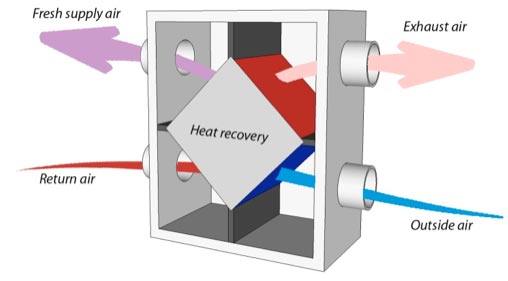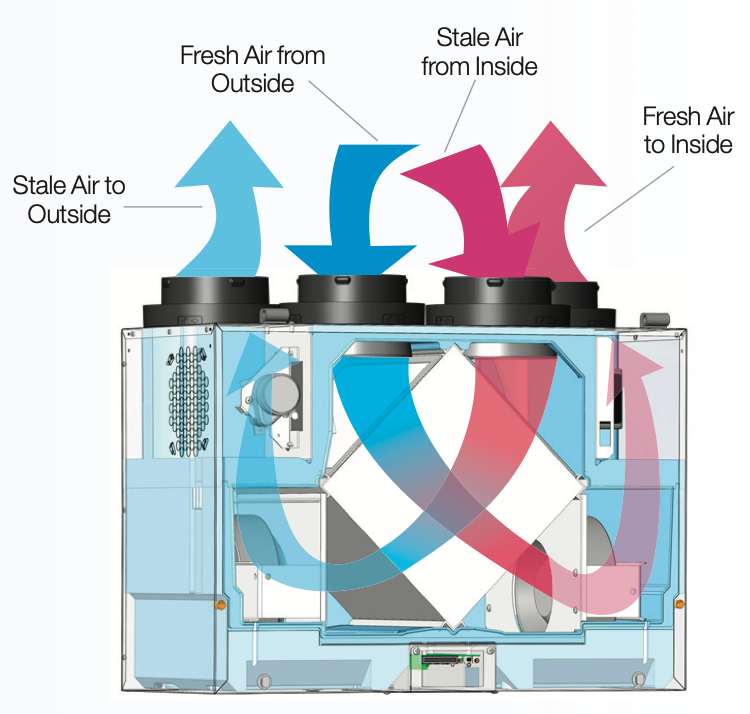Ways to Cut Costs with HRV in Warm Climates
Wiki Article
The All-Inclusive Guide to the Uses of Heat Recovery Ventilation in Modern Structures
Heat Recovery Ventilation (HRV) systems represent a substantial advancement in constructing innovation (HRV Heat Recovery Ventilation). They give a method for trading stale indoor air with fresh exterior air while reducing energy loss. This method not just enhances indoor air top quality however likewise contributes to energy effectiveness in both household and business buildings. Understanding the various applications and benefits of HRV can disclose its crucial function in modern layout and sustainability efforts. The ramifications of this technology deserve checking out betterRecognizing Heat Recovery Ventilation Equipments

Numerous modern buildings focus on energy performance, comprehending warm healing air flow (HRV) systems is important for optimizing interior air top quality and reducing power intake. HRV systems work by transferring heat from stagnant interior air to incoming fresh air, effectively keeping comfortable indoor temperatures while reducing energy loss. These systems contain a heat exchanger, fans, and ductwork that promote the flow of air. During winter months, HRV units record and reuse warmth from the outgoing air, while in summer, they can aid cool incoming air. By continually trading air, HRV systems additionally minimize humidity and the focus of indoor toxins. Correct installation and upkeep of HRV systems are crucial for their performance and efficiency in boosting overall building efficiency and comfort.
Advantages of Heat Recovery Ventilation
Heat recovery ventilation systems offer various benefits that enhance both energy performance and interior air quality in modern-day buildings. By recording and reusing energy from exhaust air, these systems considerably reduce cooling and heating costs, causing reduced power usage. Furthermore, they keep a steady circulation of fresh outside air, lessening the risk of interior air toxins and irritants. This continuous exchange assists regulate humidity degrees, preventing mold and mildew development and guaranteeing a healthier living setting. Additionally, HRV systems add to sustainability goals by reducing total carbon footprints. Their ability to maximize ventilation without sacrificing thermal convenience makes them a useful enhancement to modern structure layout, advertising both financial and ecological advantages.Applications of HRV in Residential Buildings
As property owners progressively prioritize power performance and interior air high quality, the applications of warmth recuperation ventilation (HRV) systems in property buildings have actually come to be a lot more common. HRV systems are specifically advantageous in tightly sealed homes, where keeping fresh air flow is necessary for protecting against wetness build-up and indoor toxins. They efficiently transfer warmth from outbound stagnant air to inbound fresh air, decreasing energy costs connected with cooling and heating. Additionally, HRVs can boost convenience levels by controling moisture and temperature. They are likewise adaptable for various household designs, including single-family homes and multi-unit buildings. In general, integrating HRV systems sustains sustainable living techniques while making sure a healthier indoor atmosphere for owners.HRV in Commercial and Industrial Setups
In industrial and commercial settings, the implementation of warmth recuperation air flow (HRV) systems has actually come to be increasingly important for optimizing energy performance and preserving air top quality. These systems successfully transfer warm from exhaust air to incoming fresh air, lowering the demand for added home heating or air conditioning. This not just lowers power prices but also adds to sustainability initiatives. Industries such as manufacturing, warehousing, and office complex benefit considerably from HRV systems, as they aid manage temperature and moisture levels, making sure a comfy and efficient setting. In addition, HRV systems help in removing pollutants and excess dampness, improving HRV Heat Recovery Ventilation indoor air high quality. As laws around air high quality come to be stricter, the adoption of HRV innovation is most likely to expand, making it a vital component of modern commercial and industrial framework.Future Patterns in Heat Recovery Ventilation Modern Technology

Frequently Asked Questions
Just How Does Heat Recovery Ventilation Impact Indoor Air Quality?
Heat recovery ventilation significantly boosts interior air high quality by continuously trading stale indoor air with fresh outdoor air while recuperating power. This process minimizes pollutants, preserves perfect moisture degrees, and guarantees a much healthier setting for owners.Can HRV Solutions Be Installed in Existing Buildings?
HRV systems can undoubtedly be installed in existing buildings. Retrofitting may call for alterations to ductwork and ventilation layouts, but it substantially enhances power effectiveness and interior air quality, making it a feasible choice for older structures.What Maintenance Is Required for HRV Solutions?

Are There Details Climates Where HRV Is Extra Reliable?
Heat recovery ventilation systems are especially effective in environments with significant temperature differences in between periods. These systems maximize power performance by recuperating heat from exhaust air, making them excellent for both cool and reasonably cozy settings.Exactly How Do HRV Equipments Affect Power Bills?

Report this wiki page